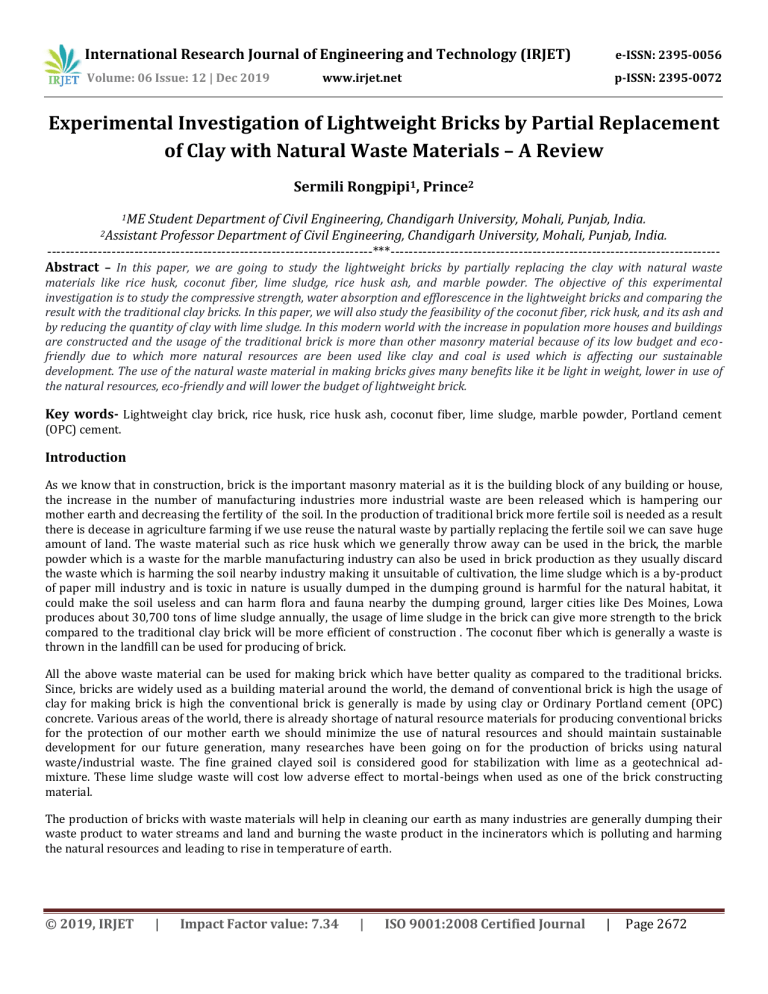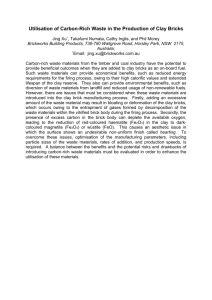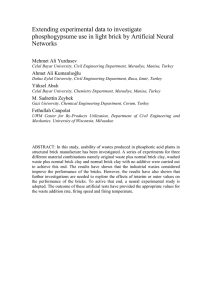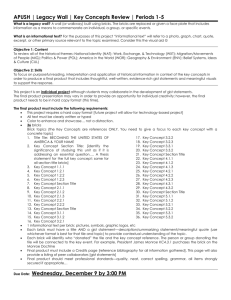IRJET-Experimental Investigation of Lightweight Bricks by Partial Replacement of Clay with Natural Waste Materials – A Review
advertisement

International Research Journal of Engineering and Technology (IRJET) e-ISSN: 2395-0056 Volume: 06 Issue: 12 | Dec 2019 p-ISSN: 2395-0072 www.irjet.net Experimental Investigation of Lightweight Bricks by Partial Replacement of Clay with Natural Waste Materials – A Review Sermili Rongpipi1, Prince2 1ME Student Department of Civil Engineering, Chandigarh University, Mohali, Punjab, India. Professor Department of Civil Engineering, Chandigarh University, Mohali, Punjab, India. -----------------------------------------------------------------------***-----------------------------------------------------------------------Abstract – In this paper, we are going to study the lightweight bricks by partially replacing the clay with natural waste 2Assistant materials like rice husk, coconut fiber, lime sludge, rice husk ash, and marble powder. The objective of this experimental investigation is to study the compressive strength, water absorption and efflorescence in the lightweight bricks and comparing the result with the traditional clay bricks. In this paper, we will also study the feasibility of the coconut fiber, rick husk, and its ash and by reducing the quantity of clay with lime sludge. In this modern world with the increase in population more houses and buildings are constructed and the usage of the traditional brick is more than other masonry material because of its low budget and ecofriendly due to which more natural resources are been used like clay and coal is used which is affecting our sustainable development. The use of the natural waste material in making bricks gives many benefits like it be light in weight, lower in use of the natural resources, eco-friendly and will lower the budget of lightweight brick. Key words- Lightweight clay brick, rice husk, rice husk ash, coconut fiber, lime sludge, marble powder, Portland cement (OPC) cement. Introduction As we know that in construction, brick is the important masonry material as it is the building block of any building or house, the increase in the number of manufacturing industries more industrial waste are been released which is hampering our mother earth and decreasing the fertility of the soil. In the production of traditional brick more fertile soil is needed as a result there is decease in agriculture farming if we use reuse the natural waste by partially replacing the fertile soil we can save huge amount of land. The waste material such as rice husk which we generally throw away can be used in the brick, the marble powder which is a waste for the marble manufacturing industry can also be used in brick production as they usually discard the waste which is harming the soil nearby industry making it unsuitable of cultivation, the lime sludge which is a by-product of paper mill industry and is toxic in nature is usually dumped in the dumping ground is harmful for the natural habitat, it could make the soil useless and can harm flora and fauna nearby the dumping ground, larger cities like Des Moines, Lowa produces about 30,700 tons of lime sludge annually, the usage of lime sludge in the brick can give more strength to the brick compared to the traditional clay brick will be more efficient of construction . The coconut fiber which is generally a waste is thrown in the landfill can be used for producing of brick. All the above waste material can be used for making brick which have better quality as compared to the traditional bricks. Since, bricks are widely used as a building material around the world, the demand of conventional brick is high the usage of clay for making brick is high the conventional brick is generally is made by using clay or Ordinary Portland cement (OPC) concrete. Various areas of the world, there is already shortage of natural resource materials for producing conventional bricks for the protection of our mother earth we should minimize the use of natural resources and should maintain sustainable development for our future generation, many researches have been going on for the production of bricks using natural waste/industrial waste. The fine grained clayed soil is considered good for stabilization with lime as a geotechnical admixture. These lime sludge waste will cost low adverse effect to mortal-beings when used as one of the brick constructing material. The production of bricks with waste materials will help in cleaning our earth as many industries are generally dumping their waste product to water streams and land and burning the waste product in the incinerators which is polluting and harming the natural resources and leading to rise in temperature of earth. © 2019, IRJET | Impact Factor value: 7.34 | ISO 9001:2008 Certified Journal | Page 2672 International Research Journal of Engineering and Technology (IRJET) e-ISSN: 2395-0056 Volume: 06 Issue: 12 | Dec 2019 p-ISSN: 2395-0072 www.irjet.net Literature review Rohit Kumar Arya and Rajeev Kansal (2016), the researches has investigated that the desirable compressive strength shown by the tested specimen, it is clear that paper Crete have the ability to provide a eco-friendly light weight brick with the use of less number of natural resource due to lesser weight and more flexibility, these bricks are potentially ideal material for earthquake foundation. Sutas Janbuala and Thanakon Wasanapiarnpong (2016), they successfully demonstrated that the density of the clay brick is reduced by the addition of bagasse into the raw material. While an increase in bagasse contain results in decrease in the compressive strength of the specimen, and increase in firing temperature led to an increase in density and compressive strength. Furthermore an increase in bagasse contains also results in increase porosity and absorption of specimens. Maneesh Kumar et-al (2015), the research is done to investigate that the reuse of paper mill waste holds the moisture in the pores and fibrous envelops providing obstacle for moisture to move towards the surface. Fibrous nature gives very high energy absorbing ability and hence the high compressive strength. Mohammad Shahid Arshand and Dr. P.Y. Pawade (2014), the research is done to investigate that the coconut waste can be utilized for making light weight bricks. The fibrous nature of coconut gives very high absorbing ability and good compressive strength. Aeslima Binti Abdul Kadir et-al (2014), the research is done to investigate that the utilization of different types of sludge waste into fired clay bricks always obtain various advantages in terms of physical and chemical properties such as low density, light weight bricks, better strength band even reducing energy consumption during firing. Lianyang Zhang (2013), the researcher investigated that the use of bricks which are made from waste materials are very limited, the possible reason may be the contamination present in waste material, the absence of relevant standards. Conclusions From the above study the following conclusion can be drawn1. 2. 3. 4. 5. From the research we get to know that marble powder gives more strength to the brick as compared to the conventional brick. Lime sludge is a low cost , calcium carbonate rich material that can be used as a binder cum inert filler material to improve the packing and densification of clay based bricks. Coconut fiber can be easily handled and can be utilized for making light weight bricks. The rice husk ash gives strength to the brick while the rice husk helps the brick to be light in weight. The usage of natural waste material is beneficial to the society and is environmental friendly and it lowers the cost of production of bricks as we are using waste materials. References 1. 2. 3. 4. 5. 6. 7. Prof. Vivek R. Kasar, Namrata S. Tikhe, Sneha V. Dhanawade, Sunil A. Dhanawade, Sumit R. Gosavi (2018), Reuse of natural waste material(coconut waste) making for light weight bricks, Vol 05 Issue-04, April 2018. Abhishek Chanchal and Ritesh Jain (2018), A review on possibility of bricks with municipal solid waste, Issue 05, 2018 Dr. S. Krishnaiah and S.V. Giri Babu (2018), Manufacturing of Eco-Friendly Brick: A Critical Review, Volume, 08 || Issue, 2|| February – 2018. Muhammad A. Saleem, Syed M.S. Kazmi and Safeer Abbas (2017), Clay Bricks Prepared with Sugarcane Bagasse and Rice Husk Ash – A Sustainable Solution, Assistant Professor, Department of Civil Engineering, University of Engineering and Technology, Lahore, Pakistan. G.Balaji, G.Sanjiv krishnan, R.Jaya prakash raj, M.Balakrishnan J.Harikaran (2017), Preparation of Alternative Bricks by using wood ash and quarry dust, Volume 4, Issue 3, March-2017. Raju Sarkar, Ankur Mudgal, Ritesh Kurar (2017), Use of paper mill waste for brick making, Issue 13 November 2017. Prof. Roshan S. Satpute, Prof. Niklesh R. Murekar, Prof. Manish M. Chaudhari (2017), Using Waste Material for Making Light Weight Bricks, Volume: 5 Issue: 1(Special Issue 21-22 January 2017). © 2019, IRJET | Impact Factor value: 7.34 | ISO 9001:2008 Certified Journal | Page 2673 8. 9. 10. 11. 12. 13. 14. 15. 16. 17. 18. 19. 20. 21. 22. International Research Journal of Engineering and Technology (IRJET) e-ISSN: 2395-0056 Volume: 06 Issue: 12 | Dec 2019 p-ISSN: 2395-0072 www.irjet.net Rohit Kumar Arya, Rajeev Kansal (2016), Utilization of waste papers to produce eco-friendly bricks. Volume 5 Issue 8, August 2016. Sutas Janbuala and Thanakorn Wasanapiarnpong (2016), Lightweight clay brick ceramic prepared with bagasse addition, Department of Materials Science, Faculty of Science, Chulalongkorn University, Bangkok, Thailand, VOL. 11, no. 13, JULY 2016. R.Nithiya, Chris Anto.L, K.R.Vinodh, Dr.C.Anbalagan (2016), Experimental investigation on bricks by using various waste materials, Vol-06, Issue 03 January 2016. Riyaj K. Mulla, Digambar S. Chavan, Vikas V. Lengare (2015), Use of paper mill sludge and cotton waste in clay bricks manufacturing, Vol-02, Issue-04 April, 2015. Maneesh Kumar, Ashik Moulana, Venkateshan M (2015), AN EXPERIMENTAL STUDY ON USEOFRECYCLE PAPER MILL WASTE IN LIGHT WEIGHT BRICK, Department of Civil, IFET College of Engg.,Villupuram, Tamil Nadu, India, Vol. 01, Issue 02, May2015 Riyaj K. Mulla, Digambar S. Chavan, Vikas V. Lengare (2015), Use of paper mill sludge and cotton waste in clay bricks manufacturing, Vol-02, Issue-04 April, 2015. Mohammad Shahid Arshand and Dr. P.Y. Pawade (2014), REUSE OF NATURAL WASTE MATERIAL FOR MAKING LIGHT WEIGHT BRICKS, INTERNATIONAL JOURNAL OF SCIENTIFIC & TECHNOLOGY RESEARCH VOLUME 3, ISSUE 6, JUNE 2014. Aeslima Binti Abdul Kadir, Abbas Mohajerani, Felicity Roddick, John Buckeridge (2014), Density, strength, thermal conductivity and leachate characteristics of light-weight fired clay bricks incorporating cigarette butts, Publication date 2010/4, Journal International Journal of Civil and Environmental Engineering, Volume-2, Issue-4, Pages-10351040. Mohamad Shahid Arshad, DR. P.Y. Pawade (2014), Reuse of natural waste material for making light weight bricks, VOLUME 3, ISSUE 6, JUNE 2014. Lianyang Zhang (2013), Production of bricks from waste materials – A review, Article in Construction and Building Materials 47:643–655 · October 2013. Bachir Chemani and Halima Chemani (2013), Utilization of paper sludge in clay bricks industry to obtain lightweight material: Evidence from partial replacement of feldspar by paper sludge, Vol. 8(9), pp. 335-342, 9 March, 2013. D. Rajput and Sachin A. Mandavgane (2012), Reuse of cotton and recycle paper mill waste as building material, Department of Chemical Engineering, Anuradha Engineering College, Chikhli, Maharashtra, India, Department of Civil Engineering, VNIT, Nagpur, Maharashtra, India, Department of Chemical Engineering, VNIT, Nagpur, Maharashtra, India, Received 4 December 2011, Revised 17 February 2012, Accepted 25 February 2012, Available online 9 April 2012. Aeslina Abdul Kadir and Abbas Mohajerani (2010), An Overview of Wastes Recycling in Fired Clay Bricks, International Journal of Integrated Engineering, Vol. 4 No. 2 (2012) p. 53-69. Oti J. and Kinuthia J. (2009), Engineering properties of unfired clay masonry bricks, Department of Engineering, Faculty of Advanced Technology, University of Glamorgan, Trefforest, Pontypridd, Rhondda Cynon Taff, South Wales, CF37 1DL, United Kingdom. Received 2 January 2009, Revised 15 April 2009, Accepted 16 May 2009, Available online 22 May 2009. Paki Turgut and Halil Murat Algin (2006), Limestone dust and wood sawdust as brick material, Department of Civil Engineering, Harran University, Osmanbey Campus, Sanliurfa, TurkeyReceived 5 July 2006; accepted 21 August 2006. © 2019, IRJET | Impact Factor value: 7.34 | ISO 9001:2008 Certified Journal | Page 2674




